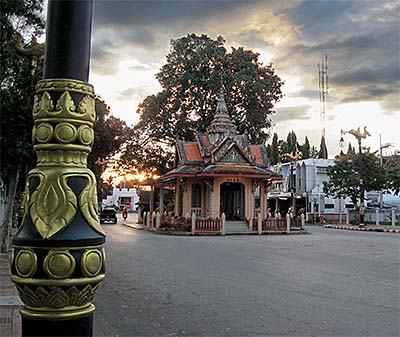1.
Kanchanaburi Town and Province
Province and town of Kanchanaburi lie at the western border of Thailand, about 130km away from the capital Bangkok. As always in Thailand, the name of the province's capital is namegiving for the province. The Province of Kanchanaburi is one of the largest in the country.
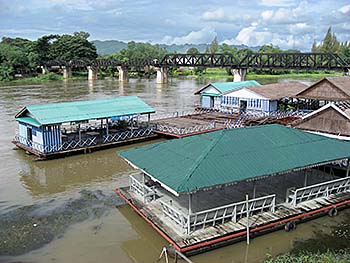
The mountains, the bridge, the river and the party boats, of who are many in Kanchanaburi. Image by Asienreisender, 10/2006
Kanchanaburi town therefore is not a big one. With it's unreliable official number of around 30,000 inhabitants, it's a place one can walk easily from one end to the other. It's situated at the confluence of the two rivers Nam Khwae Noi and Nam Khwae Yai, the second better known as the river Kwai. After the two rivers join, they form the Mae Nam Klong (river). The place became famous in a most tragical way as the theatre of the most vulnerable part of the Death Railway, which was built by forced labour of allied prisoners of war and Southeast Asians in 1942/43.
The western parts of the province are coined by the picturesque landscapes of the Tenasserim Mountains. At the Three Pagodas Pass one reaches the border to Burma/Myanmar. The mountains are partially still overgrown with tropical rainforests. Many waterfalls and caves are here. There are also three bigger hydroelectic dams (Si-Nakharin, Tha Thung Na and Khao Laem), who produce electricity mainly for the megacity Bangkok.
Most of the here living people are Thai. Minorities are of hill tribes, particularly Karen. There is also a Mon minority living in the province.
According to the massive expansion of Southeast Asia's traffic nets, the border point at Bong Ti will gain much more importance as a connection between central Thailand with the country's commercial center Bangkok and a future deepsea port at Dawei in Burma. It's planned to reestablish the railway line and additionally build a huge east-west highway.
It's a custom in Thailand (and generally in Southeast Asia) to put one's shoes out when visiting people's houses. It's a very nice custom, for it keeps the places clean. It's somewhat odd in my opinion when it's expected to do so in public places, though. Pretty strange I found it that one has to do it when using the public toilet at Kanchanaburi's bus station.

The rural surroundings of Kanchanaburi town. Image by Asienreisender, 10/2006
2.
A History of Kanchanaburi
There have been found traces of stone-age settlements in the province, who are shown in the National Museum of Ban Kao.
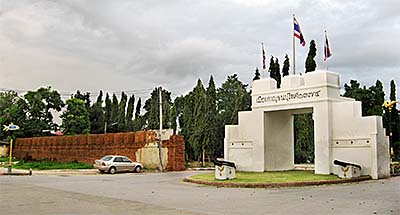
Part of Kanchanaburi's old fortification. The wall wasn't very high. Image by Asienreisender, 10/2006
The laterite temple site of Prasat Mueang Sing in Kanchanaburi Province seems to mark the western edge of the medieval empire of Angkor. The Khmers of the time invaded central Thailand in the first half of the 12th century under king Suryavarman II (the godking who ordered the construction of Angkor Wat). Prasat Mueang Sing has been subsequently built in not earlier than that time, or in later centuries. Defenitely it has at least been expanded later, because part of the compound's style follows the Bayon style of the time of king Jayavarman VII, who reigned from 1181 to supposedly 1206 or 1220 CE.
The area was certainly also of strategical importance in the Ayutthaya era, for the region was already the border region for the Siamese empire and there were posts established who informed the Siamese of invading armies from the west.
Archaeological findings in 1982 give reason to the speculation that the famous battle of the Siamese king Naresuan against a Burmese crown prince in the 16th century happened here.
The contemporary town of Kanchanaburi has been transferred to the place where it is now only in the year 1833. It had the function of being a first bastion against Burmese invaders, who entered the plains of central Thailand traditionally via the Three Pagodas Pass.
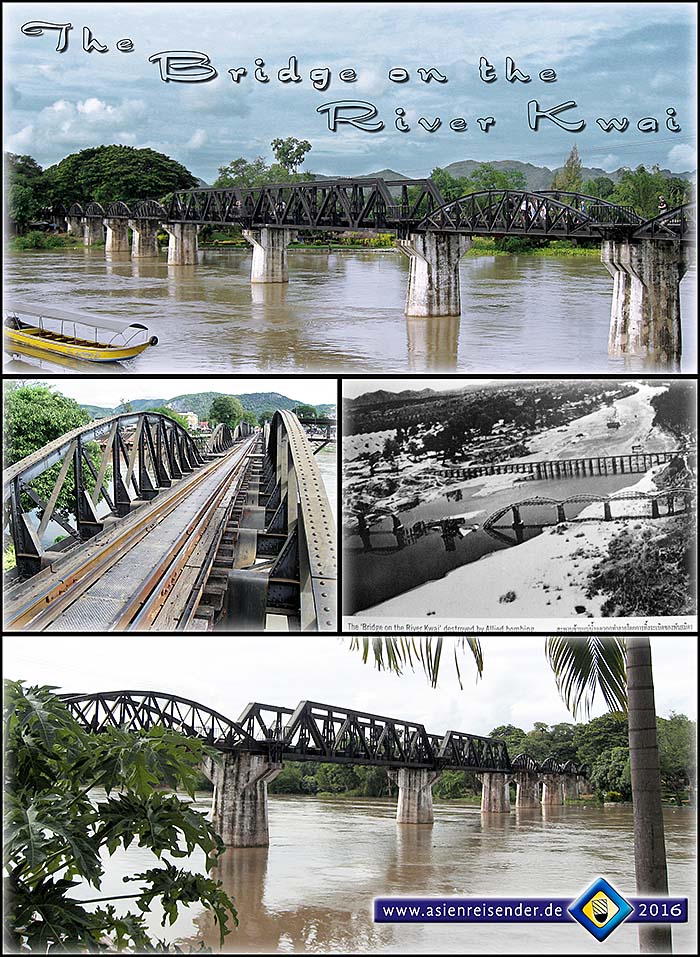
The famous bridge on the River Kwai - no beauty, but the central tourist attraction in Kanchanaburi. In the Second World War it was the weakest point of the Japanese supply line, and often attacked in air raids. The photo middle right, which is to see in the town's war museum, shows how the bridge looked after a heavy hit. In the background is the replacement for the bridge, which was used most of the time then. The first complete bridge over the river was a wooden construction, operating since February 1943, the concrete one here on the photos was finished in June 1943.
Bridge no. 277 over the River Kwai is actually a bridge over the Khwae Noi river, at the time called river Mae Klong. Anyhow, due to poor pronunciation by Westerners, Khwae mutated into 'kwai', what means water buffalo in Thai language. 'Khwae' means tributory.
The story became famous in the Sam Spiegel movie 'The Bridge on the River Kwai' (1957) with Alec Guiness in the role as Lt. Col. Nicholson. I remember watching it first time as a kid in the 1970s on a long Sunday afternoon in TV.
However, the movie is well entertaining, nice to watch but apparently very unrealistic. The prisoners are mostly in a relatively good shape, sabotage the work frequently without consequences and appear even over times so unemployed, that their moral suffers under the idleness. And that, although the Japanese commander's Saito's life depends on the deadline of the work's completion. The British commander Nicholson even falls under the sway to see the bridge as a personal challenge and supports ambitiously the Japanese war efforts at the spot. All the cruelties and strains the workers had to suffer are reduced to a few crosses on small graveyards in the background. The Asian workers are not even mentioned.
In the movie it turned out that the Japanese made crucial errors in general planning, and placing the bridge on an ill underground unable to support a heavy construction. The British then unveiled all the errors and convinced Saito of the better solutions, demonstrating Western superiority over the Japanese. That is all untrue. One can blame the Japanese here for committing war crimes, but they were excellent planners and engineers who did, in terms of organization and logistics, a great work, particularly when considering the difficulties of the circumstances. They didn't need any Western advice to fullfill the work.
In the film the bridge get's finally destroyed by the ignirion of newly developed plastic explosives at one of it's pillars. British and Americans therefore sent a small expedition all the way through the jungle to commit the destruction. That's also completely fictional.
Images and photocomposition by Asienreisender, 10/2006, 2016
In December 1941, at the same time when the attack on Pearl Harbour on Hawaii was launched, Japanese troops landed at eleven points along the western coast of peninsular Thailand. After short, but heavy fightings, the Thai government came to an agreement with the Japanese. From then on, Thailand was an ally of imperial Japan. Another view on this part of history is, that Thailand wouldn't have been able to effectively defend itself against the superior Japanese war machine. The agreement was a smart move to avoid the worst, but brought Thailand de facto in a state of occupation. Besides, the whole of Southeast Asia was under Japanese occupation from 1942 on.
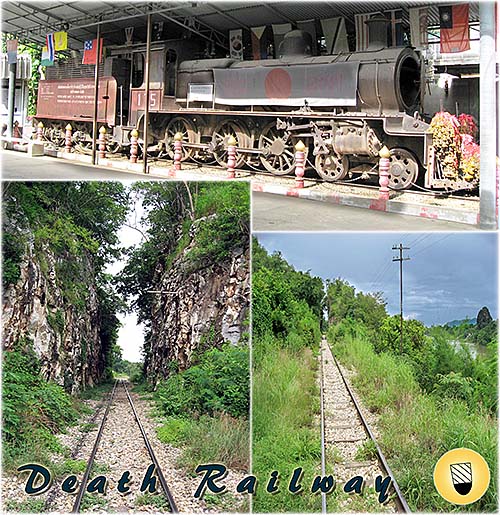
The Death Railway, actually the Thailand-Burma Railway, was built in the years 1942/43 by the Japanese army. It was meant as a war supply line for the Japanese attack on then British India. It was a 415km long stretch between Ban Pong in Thailand and Thanbyuzayat in Burma. Alltogether, the railway spanned the whole way between Bangkok (Bangkok Noi Railway Station) and Rangoon.
Up to 200,000 Asian forced labourers (civilians, called the Romusha) and 60,000 Allied prisoners of war (POW) were employed for the hard work which had to be completed as quick as possible, by all costs. The Asian workers suffered a death rate of about 50%. Of the Westerners were between 13,000 and 16,000 deaths. They were mostly British, Australians, some Americans and a considerable number of Dutch, who were brought partially from the then Dutch East Indies (Indonesia). A considerable part of the prisoners was brought from Changri Prison in Singapore.
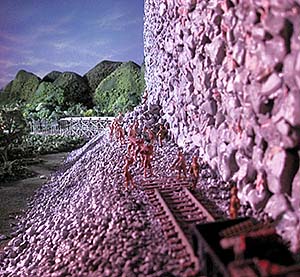
Workers, doing construction work at the Death Railway. Model seen in Kanchanaburi's War Museum. Image by Asienreisender, 10/2006
The Romushas were recruited mostly of Burmese (estimated 90,000, who saw the Japanese, at least in the first time of the occupation, as liberators from the British, and supported them) and Malays (about 75,000). Other ethnics were Chinese, Karen, Javanese and Tamil, brought from different regions of Southeast Asia. Some of the Romusha workers were lured to work here under false promises as a good salary, free housing, easy work. In fact, the work was harsh and the conditions terrible. They didn't even have latrines, food was scarce and hygiene among the masses of workers squeezed into insufficient accommodations disastrous.
Additionally there were 11,200 Japanese soldiers and 800 Korean Soldiers employed as guards, engineers and supervisors of the POW and Romusha. Although their working conditions were much better than that of the forced labourers, they lost about 1,000 men. Brutalities and harsh treatments like beatings were common among the Japanese and moreover the Koreans. For what they suffered, they treated the POW and Romusha even worse; an often appearance in any swines system.
The work was done in long shifts of up to 18 hours a day, in the tropical heat, with far too less supplies of all kind namely food, and often under the mistreatment of Japanese officers and guards.
The bulk of the construction material was brought from the dismantled track along the eastern coast of Malaya. More was brought from some sections of the East Indies railways. The line was built from both sites in Burma and Thailand simultaneously and met at completion in Sangkhlaburi district, 18km south of the Three Pagodas Pass. The whole project started with preliminary works of infrastructure in June 1942, the work on the 415km of the Death Railway started in Burma in September, in Thailand in November 1942 and was completed within the 14 months until October 1943.
After the completion of the Death Railway, some of the POWs and Asian workers were used by the Japanese for the railway line at the Isthmus of Kra, connectiong Chumpon and Kraburi.
After the war the Death Railway, respectively the treatment of the workers, was considered as a war crime. 111 Japanese officials were tried for war crimes, 32 of them sentenced to death.
Images and photocomposition by Asienreisender, 10/2006, 2016
The Japanese intention was now to attack Britain in India. Since shipping war supplies all around the Malay Peninsula into the Gulf of Bengal would have been first a long way and second a very risky one, for this gulf was still under the control of the British and American navies, it was in Japan's favour to build a land supply line from Thailand through Burma. The railway started in Bangkok and led over the Three Pagodas Pass. Employing against all international conventions prisoners of war and civilians of the occupied countries as forced labour under horrible conditions, a 100,000 Southeast Asians and 16,000 western prisoners died due to exhaustment, malnourishment, mistreatment, malaria, dengue fever and other diseases. The Japanese advance went so far until the border of India. The weakest point of the railway, however, was the Bridge over the River Kwai. Allied bombing concentrated on this point and repeatedly interrupted the supply lines.
A wider fame gained 'The Bridge on the River Kwai' with the 1957 movie with Alec Guiness. The bridge which is shown in the movie looks, by the way, completely different than the relatively unspectacular one in reality. Another, newer movie is 'Railway Man' (2013), the story of a war traumatized former POW who was employed in the construction of the Death Railway. Another movie is 'Return from the River Kwai' (1989). That's certainly the most unrealistic one, barely worth to be mentioned.
What is left from the Death Railway is the section from Bangkok Noi Railway Station (in Thonburi) via Kanchanaburi to Nam Tok. The line even goes a few kilometers farther westwards through hellfire pass, where is a little museum placed. The continuing sections were pulled out after the Second World War, allegedly to not give future Burmese invaders a mean of transport into Thailand. There are a few remaining meters railway line left at the Three Pagodas Pass.
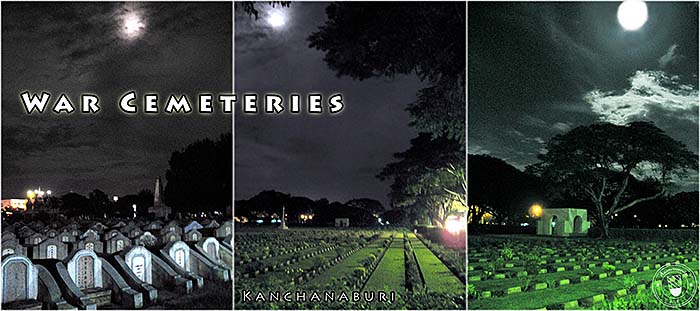
The war cemeteries as we see them now have been made after the war. In war times, victims disappear usually in anonymous mass graves. The left one, quite in the middle of town, is for Chinese victims. The mortal remains of the killed are not in the graves, for they were later no more to find respectively to identify. Images and photocomposition by Asienreisender, 10/2006, 2016
That what was actually the Death Railway, built in forced labour, was the part from Nong Pla Duk Railway Station in Ratchaburi Province on westwards, not the whole line from Thonburi) in Bangkok. Alltogether it was about 300km long inside Thailand, and more in neighbouring Burma.
3.
Economy
The fertile surroundings in the province are used for a variety of agricultural productions. Besides rice grow here sugar cane, cassava, maize, fruits and even cotton and tobacco.
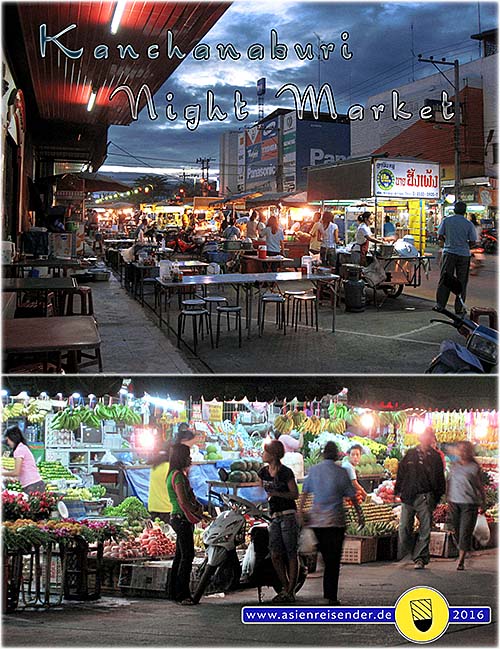
The night market and the fresh market of Kanchanaburi, close to the bus station. The night market offers a large variety of different food for little money. The fresh market is rich in food of all kinds like fruits, vegetables, fish, chicken, other meat, spices and much more. Images and photocomposition by Asienreisender, 10/2006, 2016
Another source of income is the tourism sector. A number of guesthouses, resorts and hotels target for Bangkokians, who like to spend here weekends and holidays, having heavy karaoke parties on large restaurant boats on the river. That makes the place, unfortunately, brutally noisy.
Western tourists come here often for visiting the Death Railway and the Bridge over the River Kwai, as well as the large war cemeteries and the War Museum in town. However, the ones who were personally involved in the war activities are nowadays very old and getting ever fewer in their number. The Second World War is meanwhile so long ago, that few eyewittnesses are anymore.
In the western parts of the province stretch the Tenasserim Mountains. Here are mines where sapphires and other precious stones are dug out.
In the mountains are also some national parks established. The Thungyai Naresuan Wildlife Sanctuary is even listed as a UNESCO World Heritage.
A touristic hotspot in the province is (better: was, for it's shut down meanwhile) also the notorious tiger temple Wat Pa Luangta Bua. When I came for the first time to Kanchanaburi, the tiger temple was already permanently under critic for it's shady methods to make money with drugged and ill-kept tigers. The latest news indicated that the place has been shut down eventually by the authorities. There were the remains of 60 dead tiger kittens found burried around. It was for 22 years a gold mine for a bunch of unscrupulous Buddhist monks. The temple was founded only in 1994.

Hydroelectric Dams, sometimes seen as producers of 'green energy', have always a desastrous impact on the nature. Images and photocomposition by Asienreisender, 8/2010, 2016
